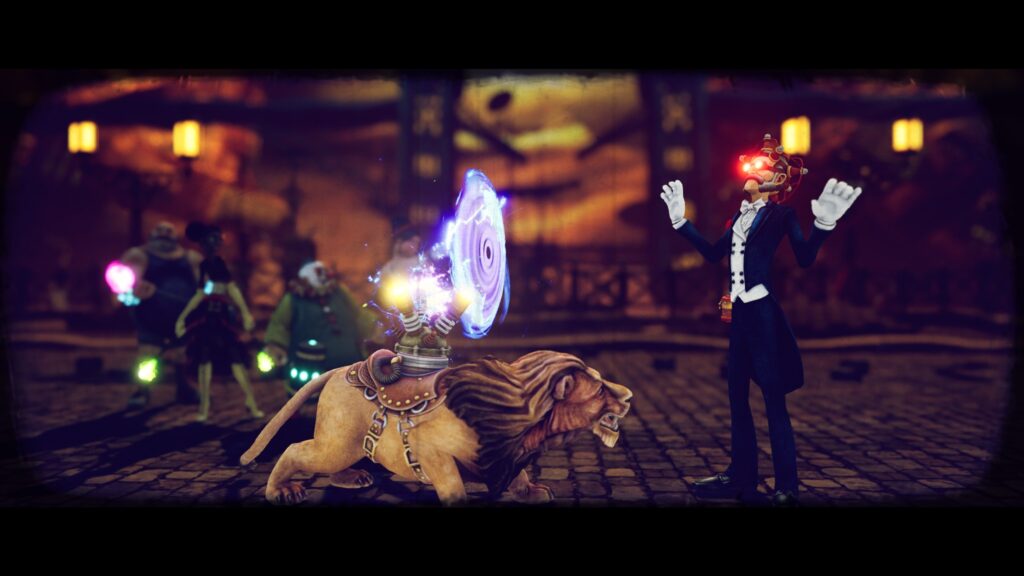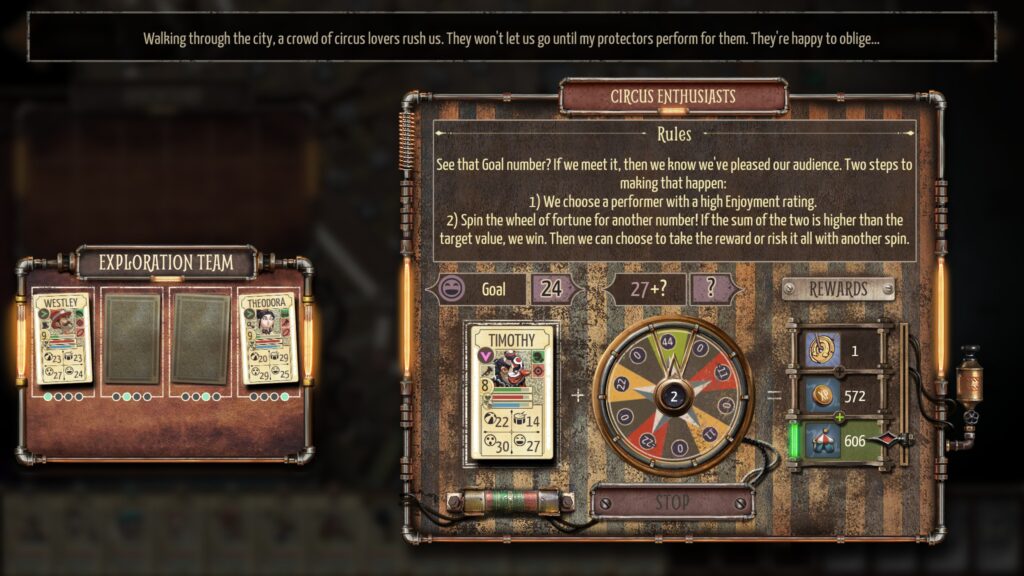
This game was never really popular and it was made by Zen Studios which is known mainly for making pinball games. I bought it because I liked its circus theming and due to its turn-based gameplay, I knew I wouldn’t have a problem finishing it. The steampunk circus theme is every bit as fun as I’d have hoped and the art and animations are great too. Unfortunately the story is an unappealing family drama and while the game mechanics are solid, they’re not interesting enough to hold up through so many battles that are more or less identical. It’s an okay game but should really be shorter than it is.
The story is set in a Victorian England where technological development has been supercharged by the discovery of something called the Spark, leading to the appearance of mechanical and electrical marvels. Circus ringmaster Randolph Masters returns from a successful career in the US to unveil the Circus Electrique in London. His niece the reporter Amelia Craig is there to interview him and also to get answers about the death of her mother who was a performer in a previous iteration of the circus many years ago. Yet at the moment that the circus’ Pillar of Power is turned on, the city’s policemen, affectionately called the Bobbies, seemingly go insane and attack everyone. The circus’ performers protect Amelia as she attempts to investigate what is going on and all clues point towards the rival Circus Mecanique. It is run by her uncle’s rival Eli Edwards and who also leads STEEM, the corporation that manufactures the many technological devices society as well as the Bobbies rely on. Despite the ongoing Maddening that is causing the crazed Vicious to attack everyone, the show must go on and so the Circus Electrique continues to hold performances.

As everyone has realized, this is really a sort of rethemed Darkest Dungeon. The circus performances are how you earn income in the form of food that is the upkeep cost of the performers, money and crafting materials. The circus as a whole serves as your base of operations where injured performers heal, where you can craft objects for use in battles or for performances, recruit new performers and so on. The real meat of the game is when Amelia embarks out into the streets of London. She’ll run into all kinds of events from just picking a chestful of free money and materials, healing opportunities, mini-games and much more. Every so often however the performers acting as her bodyguards must fight a battle and doing so causes the day to advance. There are intersections on the city map where you can choose which way to go but it’s mostly very linear. You can always look at the entire map to know in advance which events and fights are coming up and this allows you to plan. Naturally performers who are performing or engaged in any other activity back at the circus are not available to accompany Amelia on her adventures.
Combat works similarly to Darkest Dungeon in that there are two opposing teams of four combatants each arranged in a single line and positioning affects which skills can be used and which targets are valid. In addition to health, combatants have a devotion rating which when low makes them less effective and when depleted causes them to flee from combat. Unfortunately positioning alone doesn’t protect more vulnerable combatants. There are too many skills that can target the backline. The only effective way to protect your glass cannons is to have a tank character use the taunt skill or some other skills that reduces all incoming damage for the entire team. Each performer may equip items to make them more effective and can advance in levels much like any other RPG. The performers come in a number of distinct classes but even for those of the same class, there are differences in the skills they have both in combat and for circus performances, and more importantly their special bonuses. Special battles on the map allow you unlock legendary versions of classes that you may recruit later.

I found Darkest Dungeon to be a punishingly difficult game and never came close to completing it. Circus Electrique is far easier and I would argue even too easy. There are many enemy types and classes of performers you can pick for the teams you send out, but once you find a combination that works for you, you can coast through almost the entire game with only minimal changes. Some battles take place under different environment conditions so in the smog for example, the performer in the last position isn’t allowed to attack so you’d be better off placing someone in the support role there. But you don’t really need to many changes to your lineup to beat the game. This discourages experimentation with the classes that are unlocked later and contributes to the game feeling extremely repetitive. Combined with the use of consumables for emergency healing and the superskills provided through the Amaze-O-Meter, I found it easy to keep devotion more or less constantly maxed so there’s not even any time pressure similar to how stress worked in Darkest Dungeon.
In fact, I was more frustrated by the shows you’re supposed to hold every night. As each performer prefers different slots and has different chemistry with other performers, it’s quite a chore to set up a chore just right to maximize the income you earn. That’s so bad if you need to do it only every once in a while, but due to the novelty mechanic, you can’t put up the same show with the same performers filling the slots all the time. So the gameplay loop is set up a show, send the combat team out for a fight, come back to the circus to set up a new show, again and again. It’s a real pain. You can be lazy and skip doing shows sometimes or put up bad shows with easy requirements. But you would be leaving a lot of money, resources and XP gains on the table. Over time, I found it best to keep a core team of performers with universal slots, that is they are equally happy in every type of slot, and work well together, and use them exclusively for shows, never for combat. I just needed to make sure that they still earned enough XP to level at an acceptable rate in order to pull off the more complex shows as they are unlocked.

This game does have surprisingly good production values including graphics, art design, voice acting and so on even if the story is crap. Its mechanics are okay but it’s too easy to find a strategy that works and hammer the game relentlessly with your one good trick. This means that there are a lot of cool classes but relatively little incentive to experiment. The set of classes you start are already quite good! Using circus performers as combatants is amusing but it can also be confusing to work out what roles each class are best at. Who would have guessed that the Escape Artist is the best tank? Or that the Illusionist is the best DPS? It feel amazing at first to see the huge map of London and see all of the strange events and mini-games on it. But you’ll eventually groan at the repetitiveness of the fights and the events and feel that it’s just a boring grind. So many of the items you can get or craft and the skills your performers have are useless or too situational.
As it is, I’d say the game is kind of average. It feels like there are a lot of moving parts and yet the whole is less than the sum of its parts. The more of the story it revealed, the more I hated all the characters. The boss fights are okay I suppose, being decidedly different from fighting the regular enemies. I found it satisfying that I could finally beat a Darkest Dungeon style game but by the end I was just so happy to be done with it.